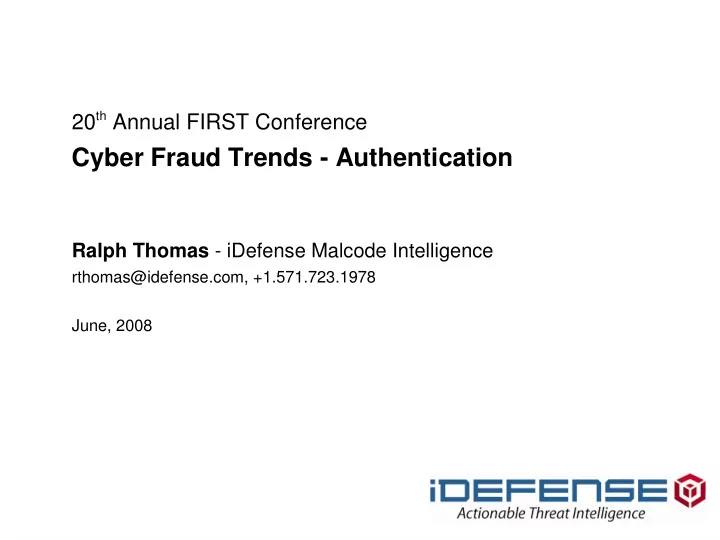

20 th Annual FIRST Conference Cyber Fraud Trends - Authentication Ralph Thomas - iDefense Malcode Intelligence rthomas@idefense.com, +1.571.723.1978 June, 2008
Cyber Fraud Disruptors Anti-virus Windows Vista Firewall − − Stopped static malware Outbound filtering enabled by default (incl. phishing filters) − Packers and scrambling is now − common practice Limit drive-by installations Windows XP SP2 Firewall − Limit malware from phoning home − Essential for attackers to maintain − Enabled by default untainted/volatile hosting − Stopped malware from coming to --> Bulletproof Hosting the computer 2FA Deployment − Start of drive-by installs via − browser exploitation (get the victim Underground economy changes to go to the malware) --> Adjusted Behaviour
Cyber Fraud Disruptors Essential for attackers to maintain untainted/volatile hosting --> Bulletproof Hosting Underground economy changes --> Adjusted Behaviour
Bulletproof Hosting The Truth About RBN − All public customers on one network − Not secretive at all, heavily spammed ads on many forums
Bulletproof Hosting The Post-RBN Era − Most popular providers existed well before the fall of RBN − Competitors to RBN, no proven connections to leadership − Common customers is NOT evidence of common leadership McColo AbdAllah RentaBL
Bulletproof Hosting - AbdAllah Reseller of a coalition of bulletproof hosts Controls one network, resells the rest
Bulletproof Hosting
"Bulletproof Hosting" - Fastflux
Bulletproof Hosting 4% 9% US 9% 4% 4% 9% US RU RU 3% 10% 4% 3% MY UA HK 3% 2% HK TR 3% 33% MY 2% 2% NL DE DE 12% 7% 7% 1% SG JP 2% ES LU GB 1% 1% UA EE CZ 1% 1% BY TH CN 16% 1% CA 26% CA 36% LU
Cyber Fraud Disruptors Essential for attackers to maintain untainted/volatile hosting --> Bulletproof Hosting Underground economy changes --> Adjusted Behaviour
Adjusted Behavior Fraud is more difficult/complex − give up! (not going to happen anytime soon) − keep current tactics and change targets go for the smaller fish, drastic increase of phishing attacks against smaller institutions, which are now faced with a 'new' problem − stay with current targets and adjust tactics due to 2FA, stolen credentials are stale move from phishing/pharming to malware All internet users are affected − financial (e-banking, e-brokerage) − e-commerce, e-recruitment, communication (e-mail, IM, blogs/forums/groups, ...) − persistent environments, social networks, and gaming
Ambush: e-Consumers Under Attack 1) WLAN: Invite for eavesdropping 1) Trojans: Bogus Software 2) Fake User: I am not me 2) With counterfeit passport into the vault 3) Detour into the bandit's camp: DNS spoof 3) Enter PIN: The crooks read along 4) Deceptive Guidepost: The hosts file
Ambush: e-Consumers Under Attack Phishing & Pharming − Lure victims via social engineering and tempering with DNS to fraudulent webpage designed to steal personal identifiable information (PII) Man-in-the-middle (MITM) − Fraudulent webpage designed to instantly defraud victims in order to circumvent temporary 2FA means Malware − Hostile software installed on the victim's computer designed to steal PII or to perform MITM. This compromises the consumer's communication endpoint.
Strong Authentication Many choices for client-side Mutual (2-way) authentication authentication Account vs. Transaction − Smart card − USB Token Authentication − Virtual Token Implementation is key − OTP Token − e.g. cell phone as OTP Token vs. − Scratch Pad mTAN − Certificate − e.g. OTP token timeout at BR bank − Biometrics − e.g. weakness in business process: change phone number − Phone/Cell/SMS − etc.
Strong Authentication
Q + A Ralph Thomas - iDefense Malcode Intelligence rthomas@idefense.com, +1.571.723.1978 May 28, 2008
Recommend
More recommend